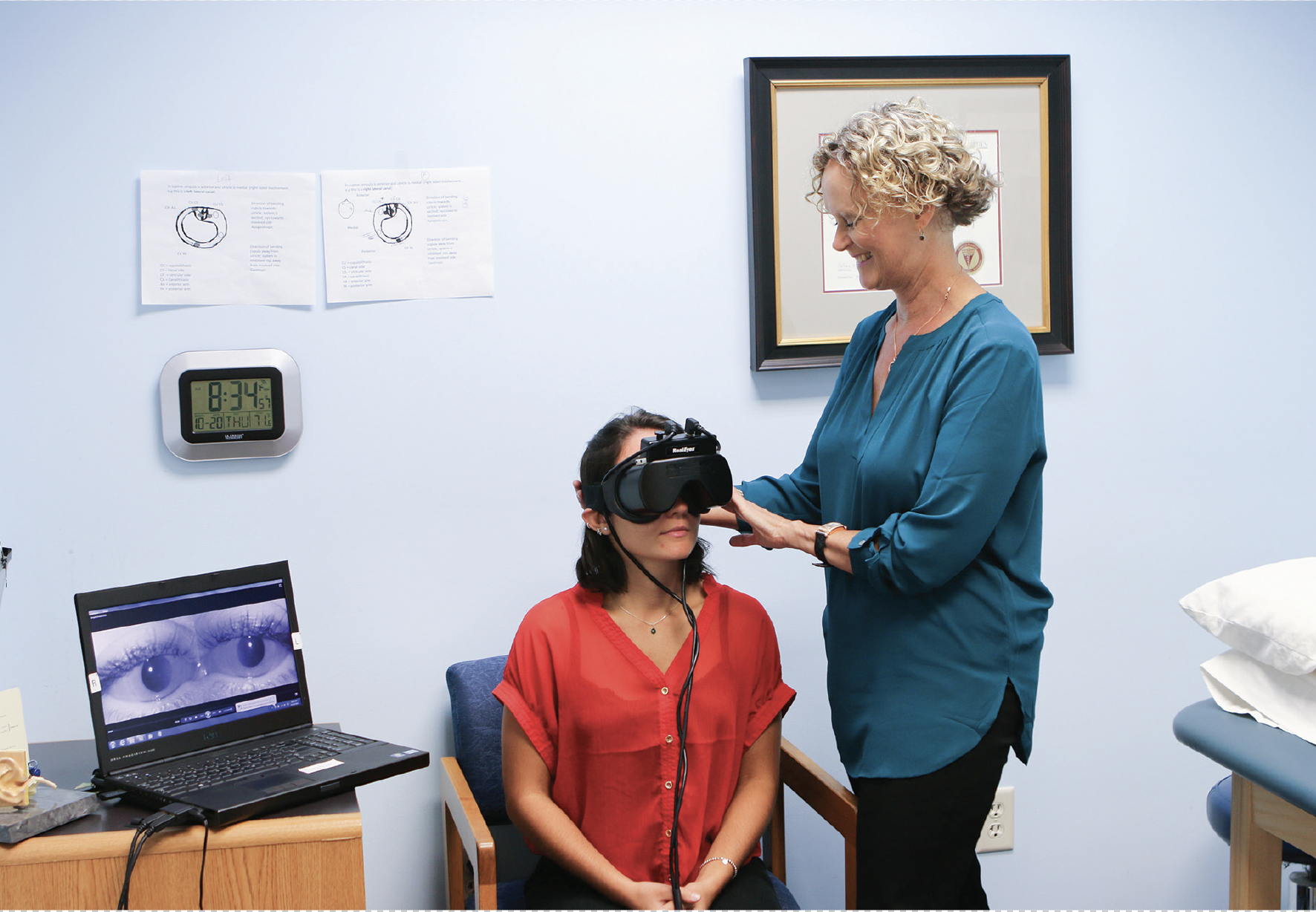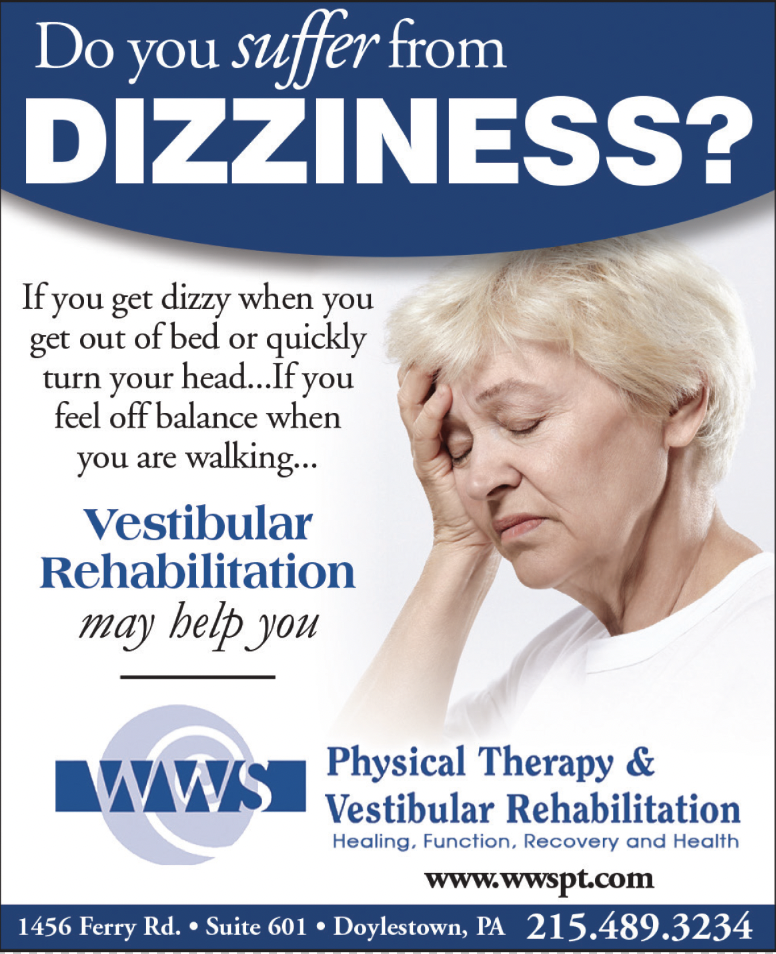Our latest article in the Bucks County Women’s Journal, BCWJ, April – May
Helping people resolve Vertigo and Dizziness symptoms is my passion. For the past 30 years at WWS Physical Therapy and Vestibular Rehabilitation, Doylestown, PA. (WWSPT), I have had the privilege of helping thousands of community members alleviate these symptoms.
Over the past few decades, the field of Vestibular Rehabilitation (VR) has dramatically expanded. Many more researchers are brilliantly discovering new and effective treatment advances to help physical therapists diagnose and care for patients suffering from Vestibular Dysfunction. To provide our clients with the best care, I strive to stay current on new studies involving vestibular diagnosis of Benign Paroxysmal Positional Vertigo (BPPV), Vestibular Migraine, Meniere’s disease, and Balance issues. How we evaluate our patients to achieve an accurate vestibular diagnosis is essential to their recovery. My staff shares this passion, and we work together to achieve the best outcomes for our patients.
What is the Vestibular System? The inner ear is a tiny but complex neural structure that coordinates with our eyes to create a clear vision, guide our muscles and postural system to help us move about with good balance, and let our brain know our direction. The semicircular canals are like a gyroscope sensing rotation, and the otoliths sense acceleration and tilting. Together, they allow us to walk, run, and play without thinking about it.
When Vestibular Dysfunction occurs, patients have symptoms of dizziness, vertigo, lightheadedness, nausea, and falling. They have difficulty moving and feel poorly. Many vestibular system disorders occur together, including the most common problem, BPPV, which often follows an attack of vestibular neuritis. Meniere’s disease and vestibular migraine have similar tinnitus symptoms, headaches, and vertigo attacks lasting 2 to 24 hours. These symptoms cause imbalance and distress for patients.
Patients have a variety of symptoms on a given day, making it difficult for healthcare providers to diagnose which type of vestibular disorder is plaguing them. With 30 years of experience in the VR field, I often see patients who have been to 4 to 5 physicians or had several ER visits because of acute vertigo,, which can present as a stroke with sudden onset. The most common disorder, BPPV, is far from benign to these patients suffering from debilitating or even disabling symptoms of spinning, nausea, vomiting, and imbalance.
At this point, when physicians refer dizzy patients to WWSPT, patients are frustrated and have begun to limit their lifestyle to avoid activities that they believe have caused an attack in the past. For example, patients avoid sleeping on a particular side because rolling to that side caused a vertigo attack three years ago. Simple avoidances for fear of triggering another episode can shrink their world.
Our role as specialists in Vestibular Rehabilitation is to become a detective. Not the type you see on TV that finds the killer or the stolen property, but a medical detective who works with your physicians to gather history and information about the tests performed. We do this by taking a detailed account and listening to a patient’s description of episodes. During the evaluation, we piece together bits of information and have the ability to connect certain things that may impact symptoms, such as stress and sleep. We may also help patients correlate other symptoms that could be related to their dizziness. For example, patients might not realize that their headaches or tinnitus are related to their episodes of vertigo. Connecting the evident and not-so-obvious dots will help determine tests to perform.
We have several types of technology to assist us. The first is called a Videonystagmoscope; an infrared video camera placed on the patient’s eyes within goggles. These goggles allow observation of the eyes’ nystagmus patterns during an exam, such as the Hallpike Dix positional test. While wearing the goggles, the patient only sees darkness, which gives us a different view of how the eyes and nervous system work in the dark compared to room light.

Interpretation of nystagmus takes skill and experience since no two patients are the same and vestibular disorders commonly overlap. The video of the nystagmus pattern is crucial in helping us discern one vestibular disorder from another and determine whether the brain is more involved than the inner ear. For BPPV, the infrared goggles diagnose which of the three semicircular canals is causing vertigo. They help therapists accurately perform treatment with maneuvers such as the Epley. The technology allows us to see if our treatment choice is patients referred by other physicians by watching the nystagmus pattern during maneuvers.
Another helpful technology is the Video Head Impulse Test (vHIT) which looks at the patient’s eyes in room light and measures the eyes’ reflexive response to quick head movements. It screens for vestibular disorders and can help diagnose inner-ear issues from central pathways of the brain linked to the ear. The information from this testing can help therapists adjust their treatment to allow patients the best recovery.

My colleagues and I at WWS Physical Therapy and Vestibular Rehabilitation, Doylestown, PA., are specialists in diagnosing and treating all vestibular disorders. The key is a thorough history and clinical exam, coupled with the latest technology to provide an accurate diagnosis and ensure we choose the best options for recovery. Please find more information about WWSPT on our website at www.wwspt.com.
Wendy Webb Schoenewald, PT, OCS,
WWS Physical Therapy & Vestibular Rehabilitation
Doylestown, PA.
(215) 489-3242

Leave a Reply